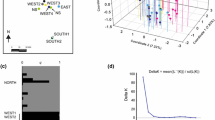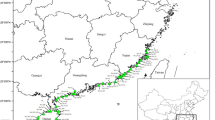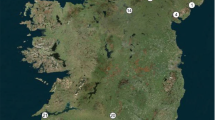Abstract
The degree of clonality, interspecific hybridisation and inbreeding in rare species will have significant implications for maintenance of genetic diversity and resilience to environmental change, with related implications for immediate conservation management. Using microsatellites, we detected extensive clonality within the rare mallee, Eucalyptus absita, from a highly disturbed agricultural habitat in southwestern Australia. A total of just 16 unique genets, plus five putative hybrids with E. loxophleba, were detected across the known species range and these genets were estimated to be of considerable age. Each location possessed a unique genotype and overall diversity was moderate (H E = 0.547). The outcrossing rate in seedling progeny was low (t m = 0.281), reflecting a rarity of intraspecific sires and minimal inbreeding depression prior to seed dispersal. Of all seedling progeny, up to 19 % were putative hybrids. Our findings indicate that despite rarity and clonality, moderate levels of genetic diversity and the capacity to produce outcrossed seeds is maintained. However, the ongoing maintenance of E. absita genetic diversity is significantly compromised by a high rate of selfing and potential hybridisation in seedling progeny. Seeds collected for long-term storage or rehabilitation should be screened for inbreeding and hybridisation rates to improve conservation outcomes. All existing adults represent a unique portion of the genepool for conservation.



Similar content being viewed by others
References
Angeloni F, Ouborg NJ, Leimu R (2011) Meta-analysis on the association of population size and life history with inbreeding depression in plants. Biol Conserv 144:35–43. doi:10.1016/j.biocon.2010.08.016
Arnaud-Haond S, Belkhir K (2007) Genclone: a computer program to analyse genotypic data, test for clonality and describe spatial clonal organization. Mol Ecol Notes 7:15–17. doi:10.1111/j.1471-8286.2006.01522.x
Bradbury D, Krauss SL (2013) Limited impact of fragmentation and disturbance on the mating system of tuart (Eucalyptus gomphocephala, Myrtaceae): implications for seed-source quality in ecological restoration. Aust J Bot 61:148–160. doi:10.1071/BT13032
Breed MF, Ottewell KM, Gardner MG et al (2015a) Mating system and early viability resistance to habitat fragmentation in a bird-pollinated eucalypt. Heredity 115:100–107
Breed MF, Ottewell KM, Gardner MG et al (2015b) Mating patterns and pollinator mobility are critical traits in forest fragmentation genetics. Heredity 115:108–114
Brondani RPV, Brondani C, Tarchini R, Grattapaglia D (1998) Development, characterization and mapping of microsatellite markers in Eucalyptus grandis and E. urophylla. Theor Appl Genet 97:816–827. doi:10.1007/s001220050961
Butcher PA, Skinner AK, Gardiner CA (2005) Increased inbreeding and inter-species gene flow in remnant populations of the rare Eucalyptus benthamii. Conserv Genet 6:213–226. doi:10.1007/s10592-004-7830-x
Byrne M (2008) Eucalypt phylogeny, diversity and evolution. In: Sharma AK, Sharma A (eds) Plant genome biodiversity and evolution. 1E Phanerogam—Angiosperm. Science Publishers, Enfield, pp 303–346
Byrne M, Hopper SD (2008) Granite outcrops as ancient islands in old landscapes: evidence from the phylogeography and population genetics of Eucalyptus caesia (Myrtaceae) in Western Australia. Biol J Linn Soc 93:177–188. doi:10.1111/j.1095-8312.2007.00946.x
Byrne M, Moran GF, Tibbits WN (1993) Restriction map and maternal inheritance of chloroplast DNA in Eucalyptus nitens. J Hered 84:218–220
Byrne M, Marquez-Garcia MI, Uren T et al (1996) Conservation and genetic diversity of microsatellite loci in the genus Eucalyptus. Aust J Bot 44:331–341
Costa e Silva J, Hardner C, Tilyard P, Potts BM (2011) The effects of age and environment on the expression of inbreeding depression in Eucalyptus globulus. Heredity (Edinb) 107:50–60. doi:10.1038/hdy.2010.154
Department of Environment and Conservation (2008) Badgingarra Box (Eucalyptus absita) Recovery Plan. Interim Recovery Plan No. 226. Department of Environment and Conservation, Perth
Doyle J, Doyle J (1990) Isolation of DNA from fresh tissue. Focus (Madison) 12:13–15
Earl DA, vonHoldt BM (2012) STRUCTURE HARVESTER: a website and program for visualizing STRUCTURE output and implementing the Evanno method. Conserv Genet Resour 4:359–361. doi:10.1007/s12686-011-9548-7
Eldridge KG, Griffin AR (1983) Selfing effects in Eucalyptus regnans. Silvae Genet 32:216–221
Evanno G, Regnaut S, Goudet J (2005) Detecting the number of clusters of individuals using the software STRUCTURE: a simulation study. Mol Ecol 14:2611–2620. doi:10.1111/j.1365-294X.2005.02553.x
Field DL, Ayre DJ, Whelan RJ, Young AG (2008) Relative frequency of sympatric species influences rates of interspecific hybridization, seed production and seedling performance in the uncommon Eucalyptus aggregata. J Ecol 96:1198–1210. doi:10.1111/j.1365-2745.2008.01434.x
Field DL, Ayre DJ, Whelan RJ, Young AG (2009) Molecular and morphological evidence of natural interspecific hybridization between the uncommon Eucalyptus aggregata and the widespread E. rubida and E. viminalis. Conserv Genet 10:881–896. doi:10.1007/s10592-008-9649-3
Gauli A, Vaillancourt RE, Steane DA et al (2013) Effect of forest fragmentation and altitude on the mating system of Eucalyptus pauciflora (Myrtaceae). Aust J Bot 61:622–632
Gill DE, Chao L, Perkins SL, Wolf JB (1995) Genetic mosaicism in plants and clonal animals. Annu Rev Ecol Syst 26:423–444
Goudet J (2001) FSTAT, a program to estimate and test gene diversities and fixation indices (version 2.9.3). Available from http://www.unil.ch/izea/softwares/fstat.html. Updated from Goudet (1995)
Grayling PM (1989) An investigation of taxonomy, reproductive biology & hybridity in four taxa of Eucalyptus of extreme rarity. Post-Graduate Diploma Thesis, The University of Western Australia
Grayling PM, Brooker MIH (1992) Four new species of Eucalyptus (Myrtaceae) from Western Australia. Nuytsia 8:209–218
Grayling PM, Knox JR (1991) (R)-4-methyl-2-pentyl acetate from Eucalyptus loxophleba. J Nat Prod 54:295–297
Griffin AR, Burgess IP, Wolf L (1988) Patterns of natural and manipulated hybridisation in the genus Eucalyptus L’Herit.—a review. Aust J Bot 36:41–66
Hardner CM, Potts BM (1997) Postdispersal selection following mixed mating in Eucalyptus regnans. Evolution (NY) 51:103–111
Head MJ, Lacey CJ (1988) Radiocarbon age determinations from lignotubers. Aust J Bot 36:93–100
Hoban S, Gaggiotti O, Bertorelle G (2013) Sample planning optimization tool for conservation and population genetics (SPOTG): a software for choosing the appropriate number of markers and samples. Methods Ecol Evol 4:299–303. doi:10.1111/2041-210x.12025
IUCN (2012) IUCN Red List Categories and Criteria: Version 3.1., 2nd edn. IUCN, Gland, Switzerland and Cambridge
Jakobsson M, Rosenberg NA (2007) CLUMPP: a cluster matching and permutation program for dealing with label switching and multimodality in analysis of population structure. Bioinformatics 23:1801–1806. doi:10.1093/bioinformatics/btm233
James SH, Kennington WJ (1993) Selection against homozygotes and resource allocation in the mating system of Eucalyptus camaldulensis Dehnh. Aust J Bot 41:381–391
James EA, McDougall KL (2007) Extent of clonality, genetic diversity and decline in the endangered mallee Eucalyptus imlayensis. Aust J Bot 55:548–553. doi:10.1071/BT06168
Jones RC, McKinnon GE, Potts BM, Vaillancourt RE (2005) Genetic diversity and mating system of an endangered tree Eucalyptus morrisbyi. Aust J Bot 53:367–377. doi:10.1071/BT04182
Kennington WJ, James SH (1997a) Contrasting patterns of clonality in two closely related mallee species from Western Australia, Eucalyptus argutifolia and E. obtusiflora (Myrtaceae). Aust J Bot 45:679–689
Kennington WJ, James SH (1997b) The effect of small population size on the mating system of a rare clonal mallee, Eucalyptus argutifolia (Myrtaceae). Heredity (Edinb) 78:252–260
Krauss SL, Hermanutz L, Hopper SD, Coates DJ (2007) Population-size effects on seeds and seedlings from fragmented eucalypt populations: implications for seed sourcing for ecological restoration. Aust J Bot 55:390–399. doi:10.1071/BT06141
Levin DA, Francisco-Ortega J, Jansen RK (1996) Hybridization and the extinction of rare plant species. Conserv Biol 10:10–16. doi:10.1046/j.1523-1739.1996.10010010.x
Lopez GA, Potts BM, Tilyard PA (2000) F1 hybrid inviability in Eucalyptus: the case of E. ovata × E. globulus. Heredity (Edinb) 85:242–250
McGowen MH, Vaillancourt RE, Pilbeam DJ, Potts BM (2010) Sources of variation in self-incompatibility in the Australian forest tree, Eucalyptus globulus. Ann Bot 105:737–745. doi:10.1093/aob/mcq036
Millar MA, Byrne M, Coates DJ et al (2000) Mating system studies in jarrah, Eucalyptus marginata (Myrtaceae). Aust J Bot 48:475–479
Millar MA, Byrne M, Coates DJ (2010) The maintenance of disparate levels of clonality, genetic diversity and genetic differentiation in disjunct subspecies of the rare Banksia ionthocarpa. Mol Ecol 19:4217–4227. doi:10.1111/j.1365-294X.2010.04817.x
Mimura M, Barbour RC, Potts BM et al (2009) Comparison of contemporary mating patterns in continuous and fragmented Eucalyptus globulus native forests. Mol Ecol 18:4180–4192. doi:10.1111/j.1365-294X.2009.04350.x
Nicolle D (2006) A classification and census of regenerative strategies in the eucalypts (Angophora, Corymbia and Eucalyptus—Myrtaceae), with special reference to the obligate seeders. Aust J Bot 54:391–407
Padovan A, Keszei A, Foley WJ, Külheim C (2013) Differences in gene expression within a striking phenotypic mosaic Eucalyptus tree that varies in susceptibility to herbivory. BMC Plant Biol 13:29. doi:10.1186/1471-2229-13-29
Peakall R, Smouse PE (2006) GENALEX 6: genetic analysis in Excel. Population genetic software for teaching and research. Mol Ecol Notes 6:288–295. doi:10.1111/j.1471-8286.2005.01155.x
Potts BM, Reid JB (1988) Hybridization as a dispersal mechanism. Evolution (NY) 42:1245–1255
Potts BM, Wiltshire RJE (1997) Eucalypt genetics and genecology. In: Williams J, Woinarski J (eds) Eucalypt ecolology. Individuals to ecosystems. Cambridge University Press, Cambridge, pp 56–91
Potts BM, Barbour RC, Hingston AB, Vaillancourt RE (2003) TURNER REVIEW No. 6 Genetic pollution of native eucalypt gene pools—identifying the risks. Aust J Bot 51:1–25
Pound LM, Wallwork MAB, Potts BM, Sedgley M (2002) Self-incompatibility in Eucalyptus globulus spp. globulus (Myrtaceae). Aust J Bot 50:365–372
Pritchard JK, Stephens M, Donnelly P (2000) Inference of population structure using multilocus genotype data. Genetics 155:945–959
Reinartz JA, Les DH (1994) Bottleneck-induced dissolution of self-incompatibility and breeding system consequences in Aster furcatus (Asteraceae). Am J Bot 81:446–455
Ritland K (2002) Extensions of models for the estimation of mating systems using n independent loci. Heredity (Edinb) 88:221–228. doi:10.1038/sj/hdy/6800029
Rossetto M, Jezierski G, Hopper SD, Dixon KW (1999) Conservation genetics and clonality in two critically endangered eucalypts from the highly endemic south-western Australian flora. Biol Conserv 88:321–331
Sampson JF, Byrne M (2008) Outcrossing between an agroforestry plantation and remnant native populations of Eucalyptus loxophleba. Mol Ecol 17:2769–2781. doi:10.1111/j.1365-294X.2008.03779.x
Sampson JF, Byrne M (2015) Assessing genetic structure in a rare clonal eucalypt as a basis for augmentation and introduction translocations. Conserv Genet. doi:10.1007/s10592-015-0781-6
Sampson JF, Hopper SD, James SH (1995) The mating system and genetic diversity of the Australian arid zone mallee, Eucalyptus rameliana. Aust J Bot 43:461–474
Sampson JF, Byrne M, Yates CJ et al (2014) Contemporary pollen-mediated gene immigration reflects the historical isolation of a rare, animal-pollinated shrub in a fragmented landscape. Heredity (Edinb) 112:172–181. doi:10.1038/hdy.2013.89
Silvertown J (2008) The evolutionary maintenance of sexual reproduction: evidence from the ecological distribution of asexual reproduction in clonal plants. Int J Plant Sci 169:157–168. doi:10.1086/523357
Smith S, Hughes J, Wardell-Johnson G (2003) High population differentiation and extensive clonality in a rare mallee eucalypt: Eucalyptus curtisii. Conserv Genet 4:289–300
Steane DA, Vaillancourt RE, Russell J et al (2001) Development and characterisation of microsatellite loci in Eucalyptus globulus (Myrtaceae). Silvae Genet 50:89–91
Tyson M, Vaillancourt RE, Reid JB (1998) Determination of clone size and age in a mallee eucalypt using RAPDs. Aust J Bot 46:161–172
Walker E, Byrne M, Macdonald B et al (2009) Clonality and hybrid origin of the rare Eucalyptus bennettiae (Myrtaceae) in Western Australia. Aust J Bot 57:180–188
Whitham TG, Slobodchikoff CN (1981) Evolution by individuals, plant-herbivore interactions, and mosaics of genetic variability: the adaptive significance of somatic mutations in plants. Oecologia 49:287–292
Acknowledgments
The authors thank the Crouch, Creswick and Wilson families for access to populations on their land.
Author information
Authors and Affiliations
Corresponding author
Ethics declarations
Conflict of interest
The authors declare that they have no conflict of interest.
Electronic supplementary material
Below is the link to the electronic supplementary material.
Rights and permissions
About this article
Cite this article
Bradbury, D., Grayling, P.M., MacDonald, B. et al. Clonality, interspecific hybridisation and inbreeding in a rare mallee eucalypt, Eucalyptus absita (Myrtaceae), and implications for conservation. Conserv Genet 17, 193–205 (2016). https://doi.org/10.1007/s10592-015-0771-8
Received:
Accepted:
Published:
Issue Date:
DOI: https://doi.org/10.1007/s10592-015-0771-8




